Do umbrella plants like to be root-bound? Let’s talk about the basic potting needs of these super popular houseplants!
What makes the Scheflera tree increasingly popular nowadays is that it’s very easy to care for and maintain.
As someone who owns and loves her umbrella plants, I can say that you hardly need to look after it!
Umbrella plants are the sturdiest ones you will ever find, and in most cases, it seems like they take care of themselves.
However, this doesn’t mean that you should completely neglect them.
Sometimes, even those who take extra care of their umbrella trees have difficulty maintaining them and keeping them healthy.
And one of the first things you need to look at while determining your plant’s health is its roots. In this case, you need to ask yourself whether they like to be root bound or not.
Today, we’re here to explore this particular subject and give you some insight into how to take care of your umbrella plant.
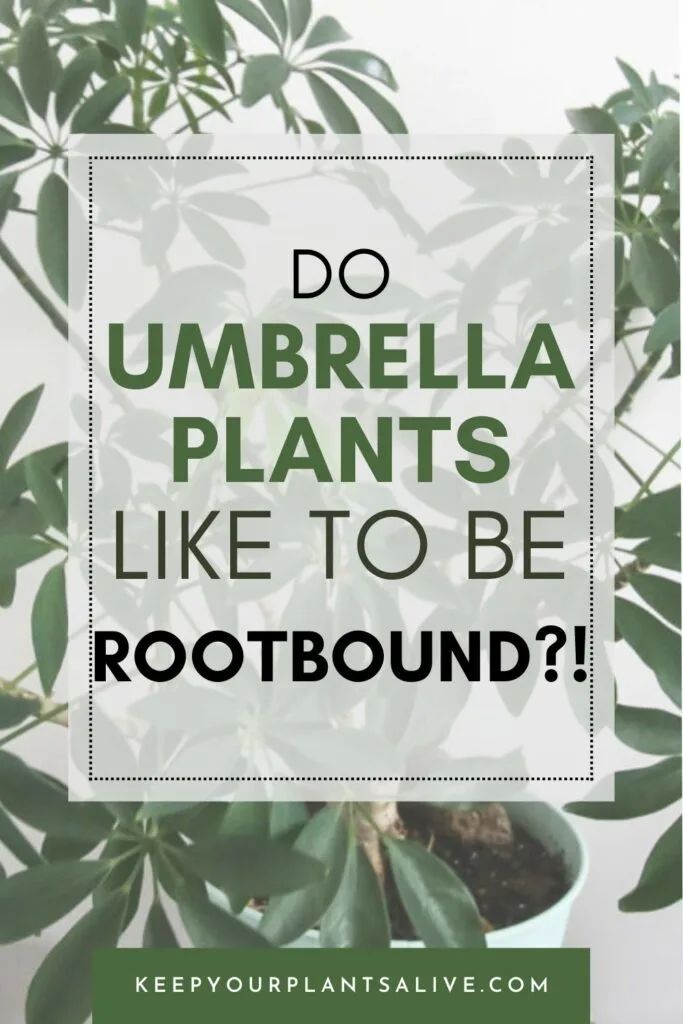
Want more umbrella plant content?
- Umbrella plant care guide
- How to propagate an umbrella plant
- Why is my umbrella plant dying?!
- Are umbrella plants toxic?
- When to repot an umbrella plant
- Can an umbrella plant live outdoors?
- Why is my umbrella plant dropping leaves?
- Why is my umbrella tree turning black?
- Why is my umbrella plant getting yellow leaves?
- Why are my umbrella plant leaves turning brown?
- Why does my umbrella plant have sticky leaves?
- Why is my umbrella plant wilting?!
- How to train your umbrella plant to grow in a specific direction
Printable Umbrella Plant care guide
Join the (free!) KeepYourPlantsAlive+ community to access this exclusive printable plant care guide! Once you sign up, you can right click & save the JPG care guide. Or keep scrolling for more!
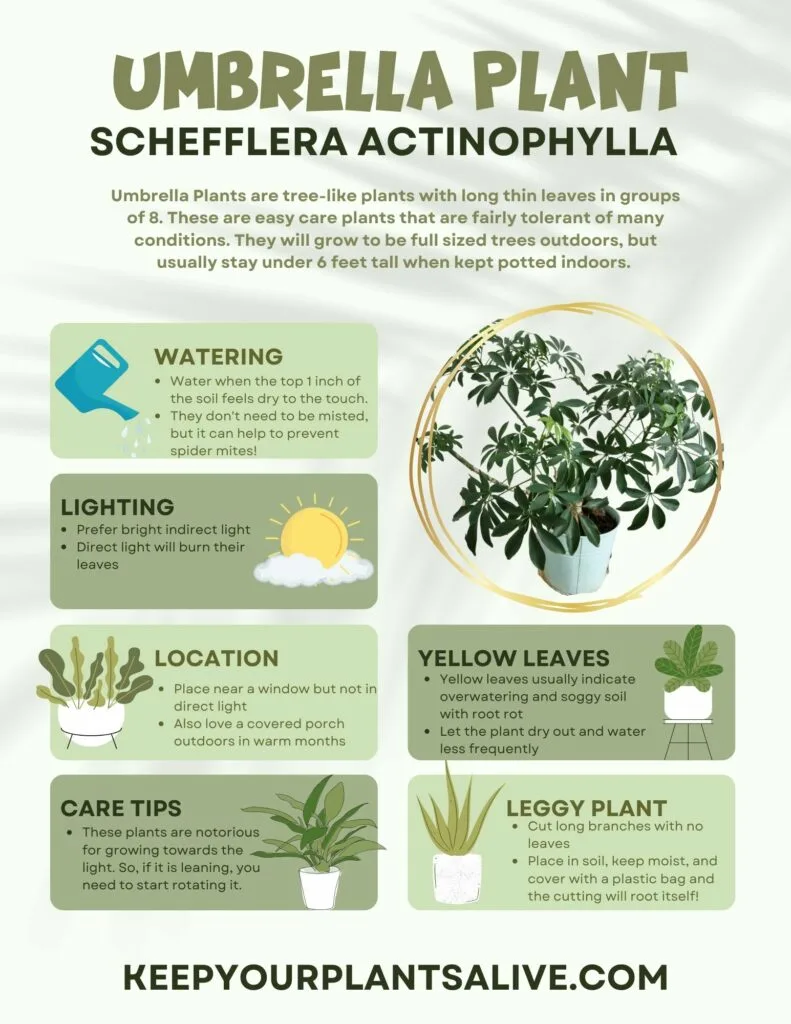
Schefflera plants potting best practices
When it comes to keeping your umbrella plants happy and healthy, you need to have a look at the pot you choose.
In most cases, it’s better to choose a larger pot than let the plant create a root ball in the small one it’s currently in.
Knowing that this plant has a fast growth rate, there’s the chance that they will quickly become root bound in a small pot.
Root bound is a name that references that keeping your plants in a smaller pot may lead to circling roots, resulting in the pot being full or even overflowing with roots.
This isn’t always a bad thing, as some plants that love being root-bounded will produce more flowers this way.
On the other hand, leaving the plant to become heavily rooted might hurt its health.
The growth rate will slow down, the nutrients will start to diminish, the soil will become dry and useless, and the leaves will start to die out.
If you notice any of these happening to your umbrella plant, then it’s time to take some action and re-pot it.
Do umbrella plants like to be root bound?
Contrary to the popular belief that these plants like to be root-bound, they actually like to have enough room to grow and develop. Yes, they can tolerate being tangled in their roots for a while, but not too long. So, ensure you’re providing them with everything they need- they will be thankful you did!
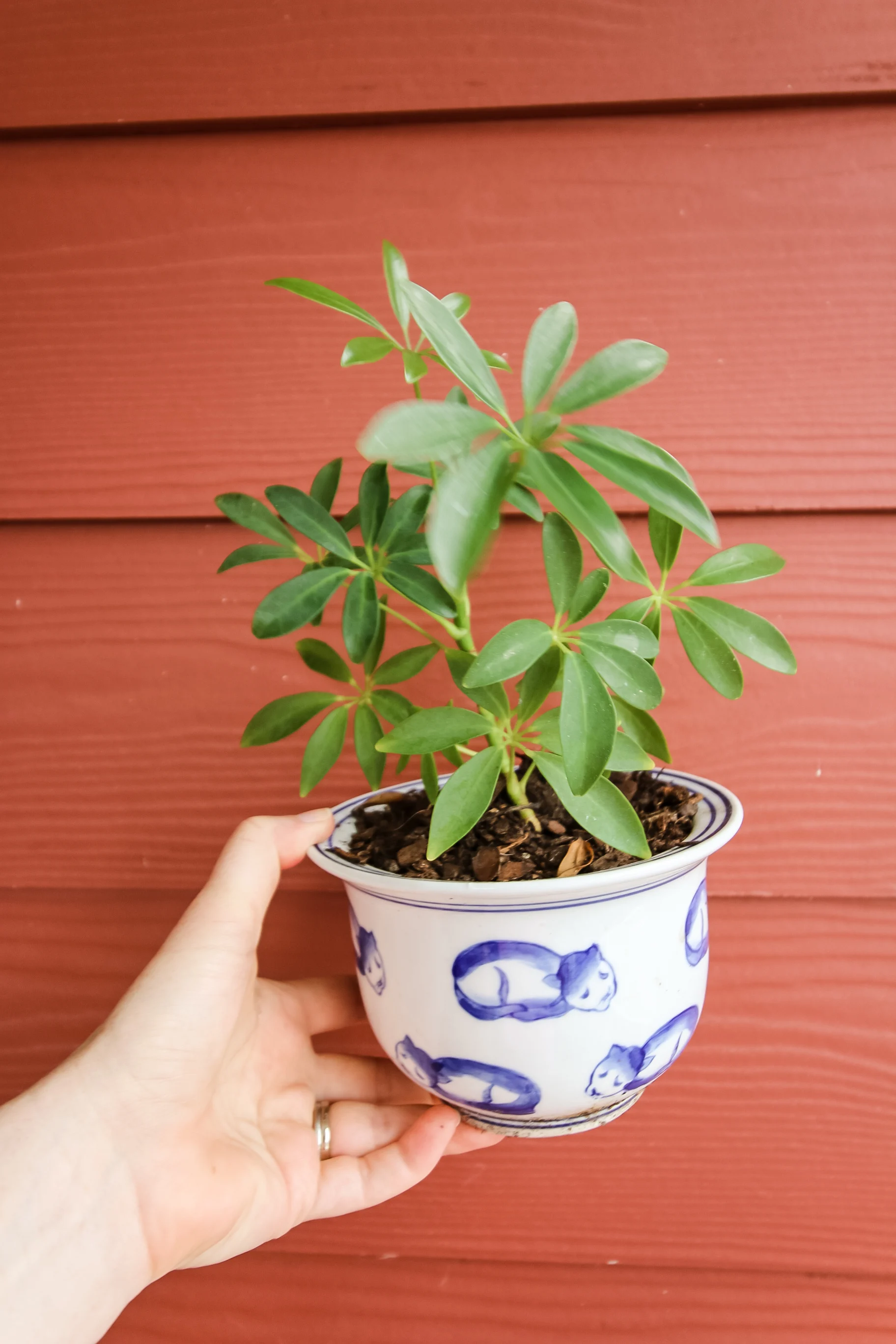
How to find out if your umbrella plants are root-bound
Just looking at your umbrella tree is not enough to see if the roots are bound or not. Take a closer pot-level look and observe.
If the plant is root-bound, then you will notice slight dehydration.
The beginning stages of root-bound plants give almost no signs, so your Schefflera may thrive as usual. But, you will notice it slowly outgrows its pot after a while.
There are a few ways that will help you determine whether your plant is root-bounded or not.
Looks all dried up
No plant should have yellowish and dry leaves, so if your Umbrella looks like this, then know something isn’t quite right.
In fact, this is the first sign that it needs to be repotted.
First, you’ll notice that the leaves start to become very dry. Slowly, they start losing their color and curl up. They become yellow and then dark brown before they fall off.
If the leaves turn brown, poring water isn’t going to save them. Nothing will save them – brown leaves don’t turn green again.
Removing the dead leaves and watering the plant won’t do much because the crowded roots cannot absorb water.
So, check the roots and see if they feel very full in the pot, poking out of drainage holes or up off the surface of the soil. In this case, replacing the pot with a bigger one is needed.
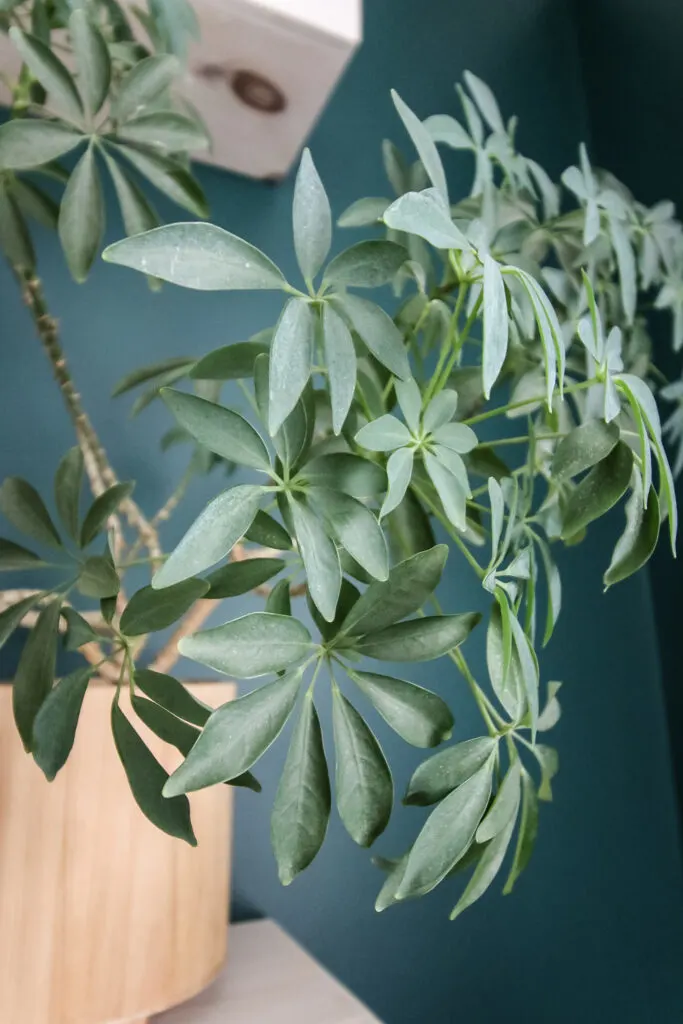
Weak stems
If you notice that the stem- and even the entire plant- starts to weaken and wilt, we can only imagine how worried you may be. This is the foundation of your plant, literally rotting away.
You are providing your plant with all the nutrients, so what is wrong? You have used organic fertilizer and excellent soil, but something still isn’t right. And the odds are, your plant needs a bigger pot!
Once the umbrella plants become root-bound, they break down all the organic materials in the soil and use them.
As soon as the roots outgrow the pot, the soil doesn’t provide enough nutrients.
The plant eventually experiences nutrient deficiency and becomes weaker.
If this is the case, repot your plant and give it the best possible light, water, and fertilization.
If it is damaged beyond repair, I suggest cutting off the unhealthy base of the stem and propagating the cuttings to grow a new plant.
The roots are everywhere
If you notice that the roots started to come out from every side of the pot, it may be time to find a bigger one.
In fact, there is no better sign to tell you that the plant you have been taking care of is finally ready to relocate.
It is marvelous to see how plants have their own ways of letting us know what they need, so it’s important that you pick up the hints.
As soon as you notice the current pot can’t contain the roots, relocate your umbrella tree to a bigger one.
I suggest a pot 1-2 inches bigger in diameter and height.

Cracks all over
Mother Nature has given each living organism enough strength to overcome any challenge – smaller spaces included.
Schefflera plants have an excellent growth rate, meaning if you keep them in one pot for a long time, they will gather strength and crack the pot.
And however amazing this may seem, it is a tell-tale sign of root-bound plants. Therefore, you needn’t waste a moment!
Go and purchase a bigger pot and repot your green tree as soon as possible.
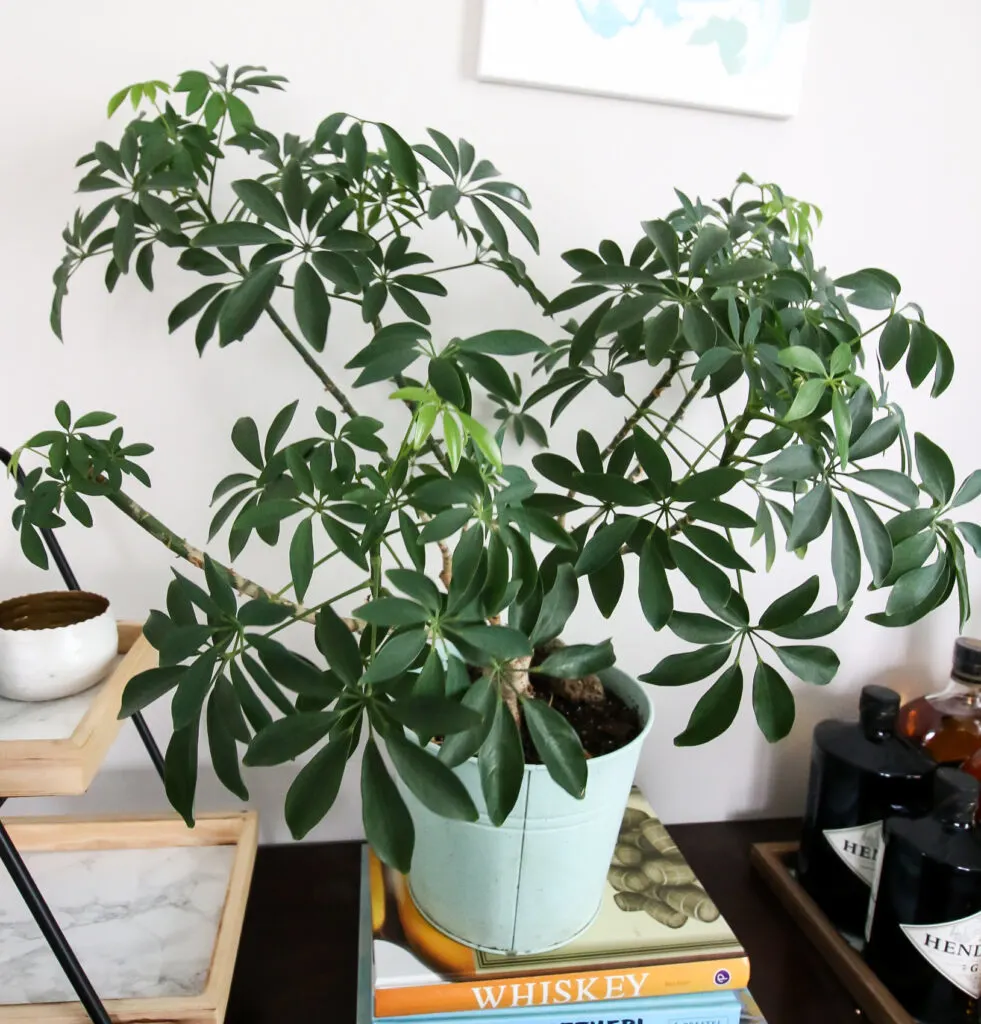
Choose the correct pot
Once you determine that your plant needs a bigger pot, you need to decide which one will make the best home for your Schefflera plant.
The first thing to consider here is the drainage. The new pot you choose should have drainage holes so the excess water can come through.
No drainage holes? Not problem! Here’s our guide to drilling drainage holes in ceramic pots.
Next are the roots. They are the reason you’re going on a pot search, aren’t they? So make sure the new pot you buy is big enough to make a difference.
Care for your Umbrella plants as best as you can to see how they keep growing year after year.
Thanks for reading!


Hey there, I’m Morgan, a houseplant enthusiast from sunny Charleston, South Carolina. Growing up surrounded by my mom’s lush orchids and African violets, I discovered the magic of bringing nature indoors. Thanks to the pandemic, I delved deeper into houseplants, discovering their power to uplift moods and transform spaces. I’m here to spill all my secrets, helping you pick the perfect houseplant – and make it happy. Let’s keep your plants alive, together! 😊
